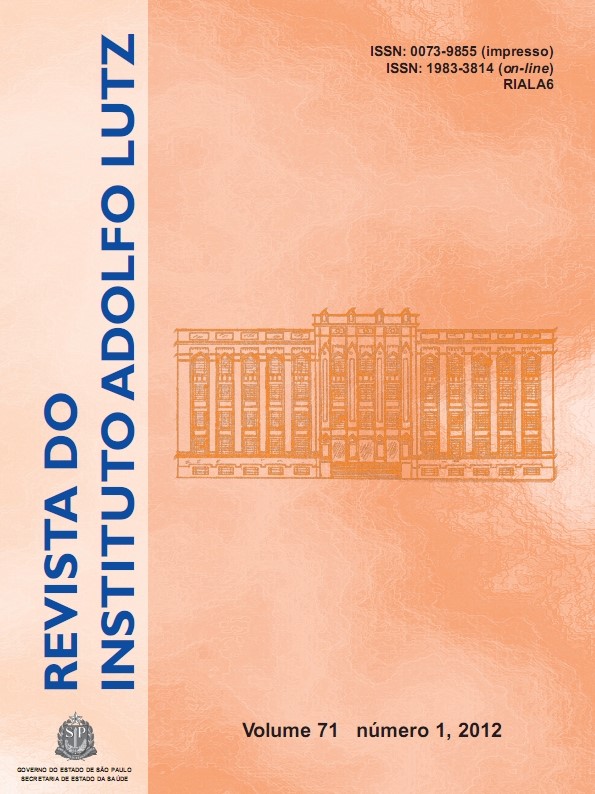Resumo
Kefir é leite fermentado produzido de forma artesanal pela adição de grãos de kefir ao leite. A manipulação doméstica e o uso de matéria-prima de diferentes padrões e origens, aliados à falta de inspeção por profissional competente, fazem do kefir um alimento capaz de apresentar perigos potenciais para a saúde humana. No presente trabalho, foi avaliada a capacidade de sobrevivência de micro-organismos patogênicos durante a fermentação do kefir. Os grãos de kefir foram adicionados a porções de leite UHT desnatado, as quais foram experimentalmente contaminadas com Escherichia coli O157:H7, Salmonella Typhimurium e Enteritidis, Staphylococcus aureus e Listeria monocytogenes. As amostras preparadas foram analisadas quanto à presença dos micro-organismos após 0, 6, 12, 24, 48 e 72 horas de fermentação. Salmonella Typhimurium e Enteritidis sobreviveram por 24 horas no kefir em fermentação. E. coli O157:H7, S. aureus e L. monocytogenes foram recuperados até 72 horas após o início da fermentação. As bactérias patogênicas estudadas, nas concentrações e condições do presente trabalho, sobreviveram por tempo superior àquele normalmente utilizado para a fermentação do kefir preparado artesanalmente, o qual representa perigo potencial para o consumo humano.Referências
1. Chen HC, Wang SY, Chen MJ. Microbiological study of lactic acid bacteria in kefir grains by culture-dependent and culture-independent methods. Food Microbiol. 2008;25:492-501.
2. Garrote GL, Abraham AG, Antoni GL. Inhibitory power of kefir: the role of organic acids.J Food Prot. 2000;63:364-9.
3. Takizawa S, Kojima S, Tamura S, Fujinagasa S, Benno Y, Nakase T. The composition of the Lactobacillus flora in kefir grains. Syst Appl Microbiol. 1998;21:121-7.
4. Witthuhn RC, Schoema T, Britz TJ. Characterization of the microbial population at different stages of kefir production and kefir grain mass cultivation. Int Dairy J. 2005;15:383-9.
5. Farnworth ER. Kefir: a complex probiotic. Food Sci Technol Bull. Function Foods. 2005;2(1):1-17.
6. Doyle GL, Abraham AG, Antoni GL. Food microbiology: fundamentals and frontiers. 2. ed. Washington: ASM; 2001.
7. Dias PA, Conceição RCS, Coelho FJO, Tejada TS, Segatto M, Timm CD. Qualidade higiênico-sanitária de carne bovina moída e de embutidos frescais comercializados no sul do Rio Grande do Sul, Brasil. Arq Inst Biol. 2008;75:359-63.
8. Conceição RCS, Hentges A, Moreira AN, Vasconcellos FA, Ângelo IMR, Carvalhal JB, et al. Isolamento de Salmonella de produtos de frango e perfil de suscetibilidade dos isolados a antimicrobianos. Rev Inst Adolfo Lutz. 2007;66:31-4.
9. U. S. Food and Drug Administration – FDA. Center for Food Safety and Applied Nutrition. Staphylococcus aureus. In: Foodborne pathogenic microorganisms and natural toxins handbook. [Accessed 2010 May 31]. Available in: [http://www.cfsan.fda.gov/~mow/chap3.html].
10. Andrews WH, Hammack T. Salmonella. U.S. Food and Drug Administration, Bacteriological analytical manual online, chapter 5, 2007. [Accessed 2010 May 31]. Available in: [http://www.cfsan.fda.gov/~ebam/bam-5.html].
11. Hitchins AD. Detection and enumeration of Listeria monocytogenes in foods. U.S. Food and Drug Administration, Bacteriological analytical manual online, Chapter 10, 2003. [Accessed 2010 May 28]. Available in: [http://www.cfsan.fda.gov/~ebam/bam-10.html].
12. Bennett RW, Lancette GA. Staphylococcus aureus. U.S. Food and Drug Administration, Bacteriological analytical manual online, chapter 12, 2001. [Accessed 2010 May 31]. Available in: [http://www.cfsan.fda.gov/~ebam/bam-12.html].
13. Gulmez M, Guven A. Behaviour of Escherichia coli O157:H7, Listeria monocytogenes 4b and Yersinia enterocolitica O3 in pasteurized and non-pasteurised kefir fermented for one or two days. Int J Food Sci Tech. 2003;9:365-9.
14. Kasimoglu A, Akgun S. Survival of Escherichia coli O157:H7 in the processing and post-processing stages of acidophilus yogurt. Int J Food Sci Tech. 2004;39:563-8.
15. Czamansky RT. Avaliação da atividade antimicrobiana de filtrados de quefir artesanal. [dissertação de mestrado em medicina veterinária preventiva]. Porto Alegre (RS): Universidade Federal do Rio Grande do Sul; 2003.

Este trabalho está licenciado sob uma licença Creative Commons Attribution 4.0 International License.
Copyright (c) 2012 Priscila Alves Dias, Daiani Teixeira da Silva, Talita Schneid Tejada, Maria Cristina Garcia Moraes Leal, Rita de Cássia dos Santos da Conceição, Cláudio Dias Timm
